We’ll just cut to the chase. If you love your kids, then you should buy a Stromberg-Carlson radio. This ad appeared in Life magazine 75 years ago today, December 9, 1946.

We’ll just cut to the chase. If you love your kids, then you should buy a Stromberg-Carlson radio. This ad appeared in Life magazine 75 years ago today, December 9, 1946.
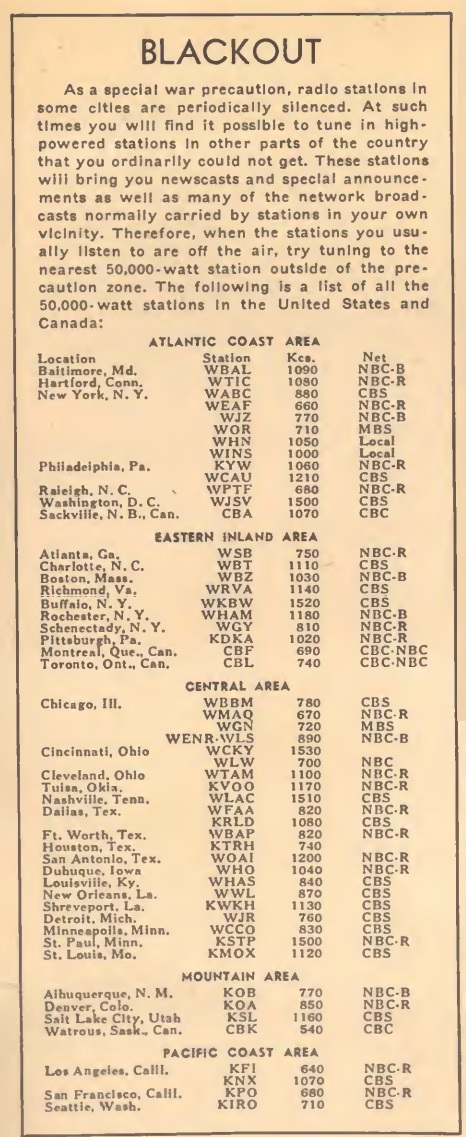 Today marks the 80th anniversary of the attack on Pearl Harbor, December 7, 1941. Here are some of our previous posts covering this event:
Today marks the 80th anniversary of the attack on Pearl Harbor, December 7, 1941. Here are some of our previous posts covering this event:
The clipping at left is from the December 20, 1941, issue of Radio Guide, the first to go to press after the attack. Very few blackouts were necessary in the Continental United States, but in the first days after Pearl Harbor, there were some fears that the Pacific Coast might be vulnerable to attack. So some radio stations went dark for a few nights in Washington, Oregon, and California. It probably wasn’t necessary after the 20th, but Radio Guide included this list of 50,000 watt stations throughout the country. If local stations went dark, this list could be consulted to find other stations carrying the same network programming.
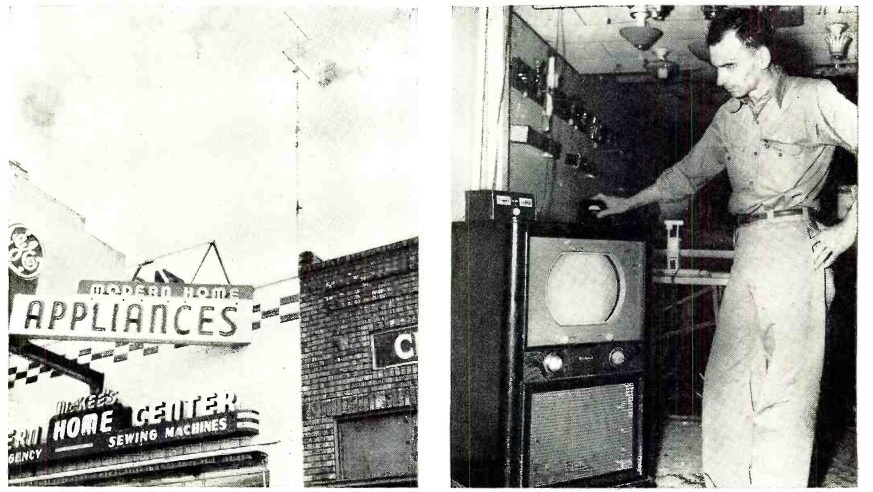 Shown here seventy years ago is Lawrence Pickerell, technician for McKee’s Modern Home Center of Longmont, Colorado. The store had entered the television business, notwithstanding the fact that the closest station was 500 miles away in Omaha, Nebraska.
Shown here seventy years ago is Lawrence Pickerell, technician for McKee’s Modern Home Center of Longmont, Colorado. The store had entered the television business, notwithstanding the fact that the closest station was 500 miles away in Omaha, Nebraska.
Pickerell, along with owner Howard McKee, had been associated with another store in Iowa. While at that store, a closer-in station was scheduled to be built, but originally, the closest station was a hundred miles away. But their store went right wo work doing everything to pull in the fringe station.
At times, reception was poor, but at other times, it was acceptable. While they didn’t make many sales at that time, they gathered a tremendous amount of local publicity, and their service department gained a lot of practical experience with television. When a local station came on the air, they already had the reputation as “the television store,” and they wound up with most of the business.
When McKee bought the store in Colorado, the situation was even worse, and they weren’t even in the fringe area of any station. Undaunted, they decided to put up a tower and hope for the best. Since the closest station in Omaha was channel 6, WOW-TV, so they put up a stacked array tuned to channel 6, and had the foresight to include a rotor. During the sprint of 1950, they pulled in other stations quite frequently due to Sporadic E, with similar results in 1951. They noted that reception was best over the noon hour, from 5:00 – 6:00 PM, and after 8:30. During 1951, 8:00 AM and early afternoon were the best. They noted that conditions were consistent with short skip on the 10 meter band.
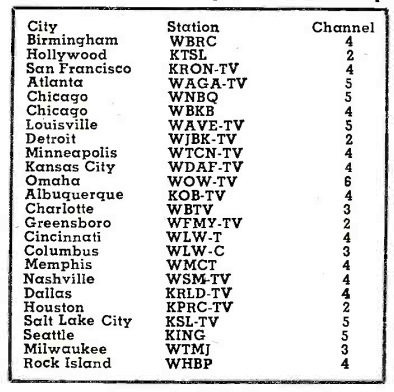 About 25% of the stations received were “program quality,” with another half being passable quality. The other 25% were intermittent. The complete log is shown here, ranging from Seattle to Atlanta. Even though the antenna was tuned to channel 6, most stations were channels 2-5. As would be expected, they didn’t pull in any high-band stations. The most consistent logging was KPRC, channel 2, Houston, Texas. In many cases, the best signal was obtained by pointing the antenna at nearby Longs Peak, elevation 14,000 feet.
About 25% of the stations received were “program quality,” with another half being passable quality. The other 25% were intermittent. The complete log is shown here, ranging from Seattle to Atlanta. Even though the antenna was tuned to channel 6, most stations were channels 2-5. As would be expected, they didn’t pull in any high-band stations. The most consistent logging was KPRC, channel 2, Houston, Texas. In many cases, the best signal was obtained by pointing the antenna at nearby Longs Peak, elevation 14,000 feet.
According to this undated matchbook, the store was playing up television, and was located at 350 Main Street. According to Google Street View, the building is still standing, and until a recent move, housed Jensen Guitars and the Willow River Music Emporium. The TV antenna appears to be gone.
The photos appeared in the December 1951 issue of Radio & Television News.
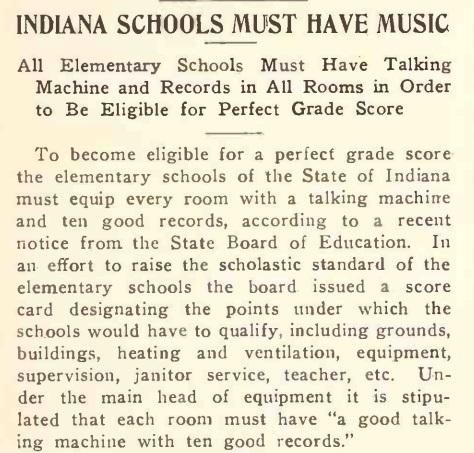 This item appeared a hundred years ago this month in the December 1921 issue of Talking Machine World. The Indiana State Board of Education determined that music was an important part of education. Accordingly, in its report card for schools, one criterion for scoring was that each elementary school in the state should equip every room with a talking machine and “ten good records.”
This item appeared a hundred years ago this month in the December 1921 issue of Talking Machine World. The Indiana State Board of Education determined that music was an important part of education. Accordingly, in its report card for schools, one criterion for scoring was that each elementary school in the state should equip every room with a talking machine and “ten good records.”
We don’t know for sure, but we’re guessing that this record would qualify as one of those ten good ones. Recorded in 1921, it’s entitled “Popular songs of yesterday” and is a medley of “Hail! Hail! The gang’s all here!” “The bowery,” “Sidewalks of New York,” ” Summertime,” and “Yip! I adde! I aye.”
You can listen by clicking the link below or by visiting the Library of Congress National Jukebox.
This handsome receiver kit was advertised in the December, 1941, issue of Radio News. Meissner Manufacturing of Mt. Carmel, Illinois, was a manufacturer of components, and also sold manufactured radios and kits. Shown here is a three-tube receiver, but it was also offered as a one or two-tube version. After mastering the one tube set, it was possible to upgrade. The three-tube set, model 10-1163, sold for $5.15, not including battery, tubes, and headphones. The one-tube set, model 10-1161, sold for $3.30, and the two-tube model, 10-1162, was priced at $3.96. They came with a coil for the standard broadcast band, and additional coils for the short waves were available.
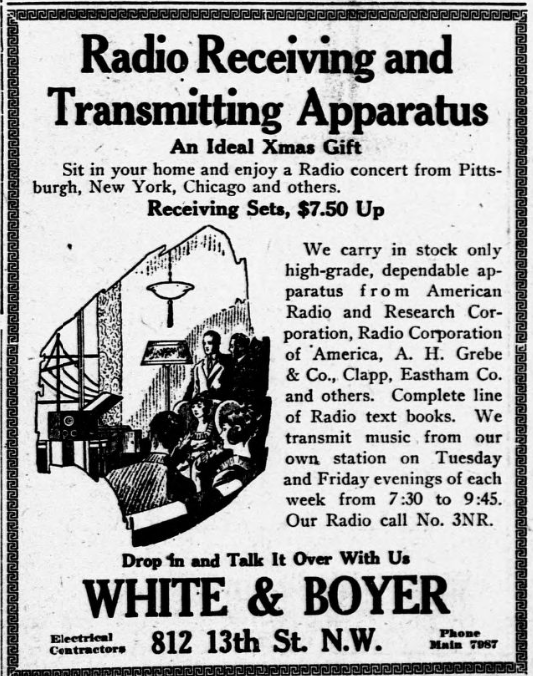 A hundred years ago today, the December 3, 1921 issue of the Washington Evening Star carried this ad for Radio Receiving and Transmitting Apparatus, “an ideal Xmas gift.” Receiving sets started at $7.50, which works out to about $116 in 2021 dollars, according to this online inflation calculator.
A hundred years ago today, the December 3, 1921 issue of the Washington Evening Star carried this ad for Radio Receiving and Transmitting Apparatus, “an ideal Xmas gift.” Receiving sets started at $7.50, which works out to about $116 in 2021 dollars, according to this online inflation calculator.
The ad was for White & Boyer, 812 13th St. NW, Washington. Like many early radio retailers, the company was also a radio station, transmitting music on Tuesday and Friday evenings from 7:30 to 9:45 PM. Shortly after this ad appeared, the station’s call sign changed from 3NR to WJH.
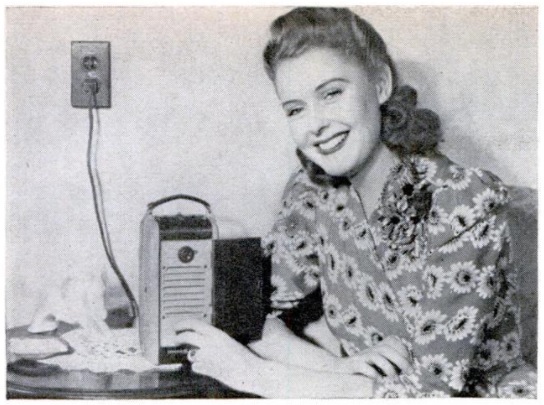 Eighty years ago, this young woman is pulling in a favorite program with this camera-style portable radio. The brand is not stated, but it has five tubes, including the rectifier, and can operate either from battery or, as she is using it here, standard household current. It had the option of use with a separate window antenna to increase the sensitivity. It was finished with gray plastic, with a dark blue covering of simulated leather.
Eighty years ago, this young woman is pulling in a favorite program with this camera-style portable radio. The brand is not stated, but it has five tubes, including the rectifier, and can operate either from battery or, as she is using it here, standard household current. It had the option of use with a separate window antenna to increase the sensitivity. It was finished with gray plastic, with a dark blue covering of simulated leather.
A few days after this picture appeared in the December 1941 issue of Popular Science, she was probably using the same set in a more somber mood to pull in the latest bulletins from Pearl Harbor.
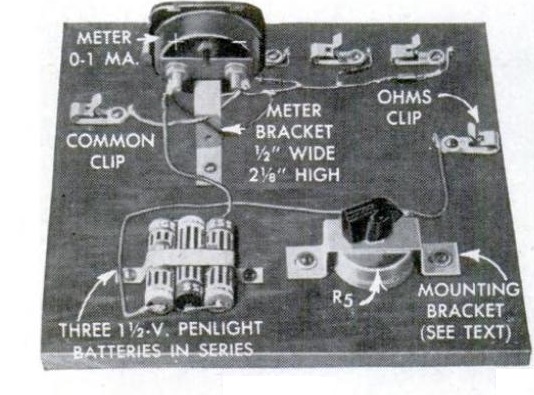 These days, there’s really no excuse not to have a multitester. Even if you only rarely dabble with electronics, every household should have one, as it will tell you things such as whether your outlet voltage is OK or if an outlet is dead. You can check batteries. (Even if a voltmeter doesn’t have a specific battery testing option, if you just check the voltage, you can tell if a battery is completely dead. And if it shows more than 1.5 volts, you can be pretty sure that the battery is good.) In the car, you can diagnose many problems simply by seeing whether 12 volts appears at a certain spot. And they are cheap. The digital model shown below (whose price includes free shipping) rivals a fine laboratory instrument 70 years ago:
These days, there’s really no excuse not to have a multitester. Even if you only rarely dabble with electronics, every household should have one, as it will tell you things such as whether your outlet voltage is OK or if an outlet is dead. You can check batteries. (Even if a voltmeter doesn’t have a specific battery testing option, if you just check the voltage, you can tell if a battery is completely dead. And if it shows more than 1.5 volts, you can be pretty sure that the battery is good.) In the car, you can diagnose many problems simply by seeing whether 12 volts appears at a certain spot. And they are cheap. The digital model shown below (whose price includes free shipping) rivals a fine laboratory instrument 70 years ago:
I am old school, and I prefer an analog meter movement, which is also available at a very reasonable price for a basic model, such as this one, which you can also get with free shipping on Amazon:
But it hasn’t always been this way, and 70 years ago, the December 1951 issue of Popular Mechanics pointed out that many beginning radio experimenters were temporarily handicapped by the inability to make measurements, since expensive test instruments were required. But fortunately, the magazine solved that problem by showing how to build test equipment, such as the volt-ohm meter shown above. An analog meter movement, a few resistors, a battery, and a few Fahnestock clips were all that were needed to make a fully functional meter suitable for most ordinary radio work. The magazine showed a similar design for a meter for AC voltage or checking capacitors. That meter also included a bridge rectifier, as well as a filament transformer for powering the capacitance meter.
The meter movement sold for $3.16, and was the most expensive component required.
Keep an eye open for coupons from the usual discount houses (the places with names such as Harbor Tool and Northern Freight). They often have the digital meters for free or practically free as a loss leader. If you need pointers on using your new meter, this classic book from Radio Shack is available on Amazon, and used copies are available at a reasonable price:
Some links on this site are affiliate links, meaning this site earns a small commission if you click on the link and make a purchase.